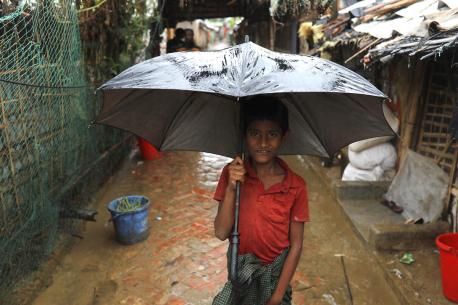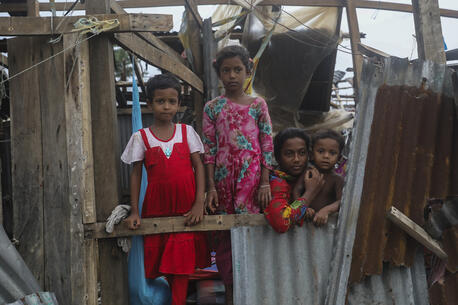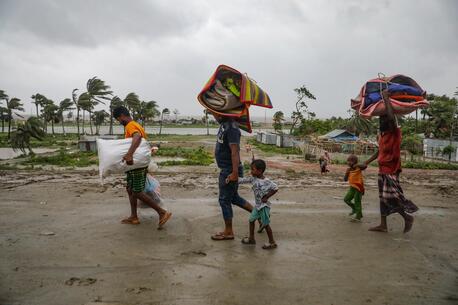
Cyclone Mocha Hits Bangladesh and Myanmar
The powerful storm destroyed homes, uprooted trees and downed power lines, leaving millions of children at risk. UNICEF is assessing the damage and ready to deliver prepositioned emergency supplies to those in need.
Already vulnerable communities braced for catastrophe as the storm neared
Millions of children are at risk after Cyclone Mocha hit southeast Bangladesh and Myanmar's Rakhine state on May 14, lashing coastal areas with heavy rainfall, a storm surge and winds up to 175 mph.
UNICEF worked closely with other UN agencies to preposition supplies and make emergency preparations as the storm system swept across the Bay of Bengal over the weekend.
One of the strongest storms to hit the region this century, Cyclone Mocha was originally expected to make landfall at the world's largest refugee camp in Cox's Bazar, Bangladesh, home to 500,000 Rohingya refugee children whose families fled neighboring Myanmar in 2017. On May 14, the storm veered south, and came ashore along the Rakhine coast, inundating low-lying areas and destroying hundreds of homes and shelters.

Children and their families need urgent assistance
Preliminary reports indicate 334,620 people in Cox's Bazar — refugees and members of the Bangladeshi community — have been affected by the storm. Homes have been damaged and destroyed, belongings lost, latrines, wells and other infrastructure in need of repair. At least 15 integrated nutrition facilities and two stabilization centers used to treat children suffering from severe acute malnutrition have been partially damaged.
It is the worst natural disaster the already fragile region has faced in the past five years.
By May 13, more than 100,000 people, including some who were already internally displaced, had moved to designated evacuation shelters in Myanmar. An estimated 200,000 people are expected to be in need of humanitarian assistance in Rakhine state, along with another 500,000 in the north, where the storm is expected to impact Myanmar's Chin state and Sagaing region. Telecommunications to the area have been cut since the storm hit, making it impossible for those affected to share an accurate update on the extent of the damage.

Readying supplies for rapid distribution, training first responders
As Cyclone Mocha neared, UNICEF staff rushed to prepare water purification tablets, shelter materials, health and nutrition supplies, water buckets, dignity and hygiene kits and other essential supplies for rapid distribution to families caught in the storm's path.
UNICEF also worked with the Government of Bangladesh to spread safety messages to protect children from drowning, abuse, violence or becoming separated from their families. Alongside partners, including sister UN agencies, UNICEF helped to train more than 3,000 refugee volunteers who are equipped to be first responders in the camps.
"Some of the world's most vulnerable children and families are, yet again, at the sharp end of a crisis they didn't create. The areas hit hardest by the storm are home to communities already living through conflict, poverty, instability, and climate and environmental shocks," said UNICEF's Executive Director Catherine Russell. "As we urgently assess and respond to the immediate needs of children in the aftermath of this cyclone, we know with certainty that the best way to save and improve the lives of children and their families is by finding long-term solutions."
HOW TO HELP
There are many ways to make a difference
War, famine, poverty, natural disasters — threats to the world's children keep coming. But UNICEF won't stop working to keep children healthy and safe.
UNICEF works in over 190 countries and territories — more places than any other children's organization. UNICEF has the world's largest humanitarian warehouse and, when disaster strikes, can get supplies almost anywhere within 72 hours. Constantly innovating, always advocating for a better world for children, UNICEF works to ensure that every child can grow up healthy, educated, protected and respected.
Would you like to help give all children the opportunity to reach their full potential? There are many ways to get involved.




